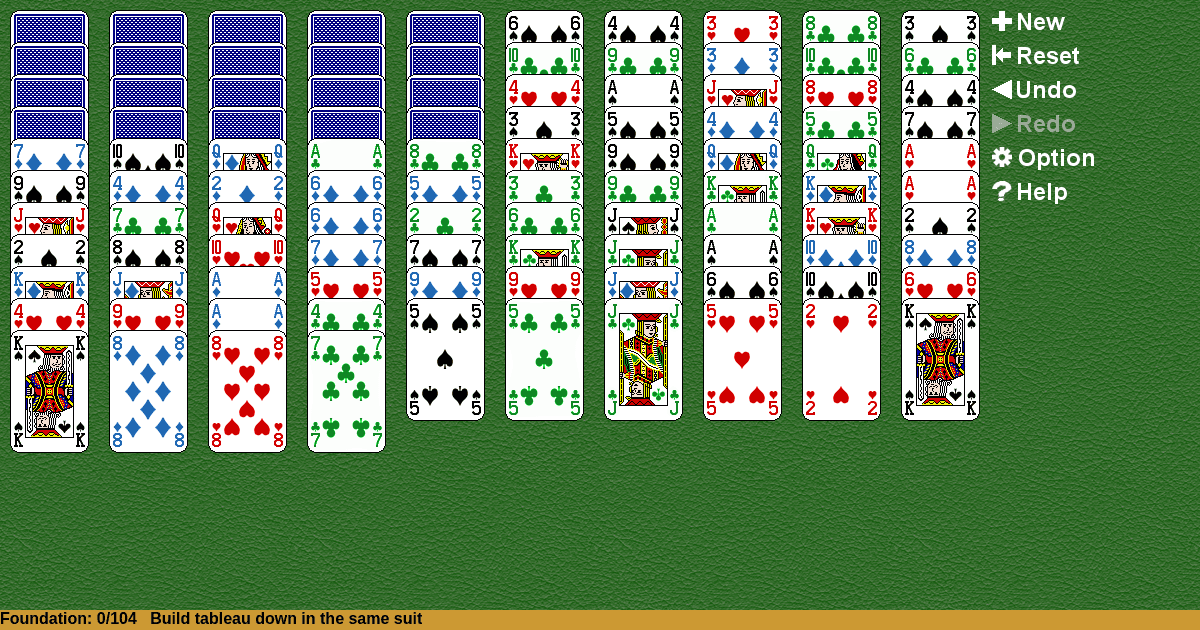Double Scorpion
Home |
How to play |
FAQ |
About
How to play Double Scorpion?
Game Objective:
The primary goal in Double Scorpion Solitaire is to assemble eight complete sequences of thirteen cards each, built in descending order (King to Ace) and in the same suit within the tableau columns. All cards must be organized into these eight suited runs to win.
Setup & Layout:
- Deck: The game uses two standard 52-card decks (104 cards in total).
- Tableau: There are 10 tableau columns (also called piles):
- Columns 1–4: Each receives 11 cards. In these columns, the bottom 5 cards are dealt face-down (hidden), and the remaining 6 cards are dealt face-up on top.
- Columns 5–10: Each receives 10 cards. All cards in these columns are dealt face-up.
- Other Areas: There are no stock, reserve, or foundation piles—all cards are dealt to the tableau at the start.
- Face-Up/Face-Down: Only the bottom cards of columns 1–4 are face-down; all other cards are face-up and immediately playable.
Double Scorpion Solitaire Rules:
- Building Sequences:
- Cards are built down in the same suit (e.g., 6♣ can only be placed on 7♣).
- Alternating colors or building by rank only is not allowed; the sequence must be strictly by suit and descending order.
- Moving Cards:
- Any face-up card can be moved, along with all cards stacked above it, regardless of their order or suit.
- When moving a group, the bottom card of the group must be placed onto a card of the same suit and one rank higher (e.g., a group starting with 9♥ can be moved onto 10♥).
- Revealing Face-Down Cards:
- When a face-down card becomes the top card of a column (i.e., all cards above it are moved), it is immediately turned face-up and becomes available for play.
- Empty Columns:
- Only a King or a group with a King at the bottom can be moved to an empty column.
- No other card or group may fill an empty space.
Gameplay:
- Player Actions:
- Move any face-up card (and all cards above it) to another column, provided the move follows the building rules (descending order, same suit).
- Reveal face-down cards as they become exposed by moving cards above them.
- Fill empty tableau columns only with a King or a sequence starting with a King.
- Sequence of Play:
- There is no stock or draw pile; all cards are in play from the start.
- Continue rearranging cards and revealing face-down cards to build complete suited sequences.
- No More Moves:
- If no legal moves remain (i.e., no cards can be moved according to the rules, and no face-down cards can be revealed), the game ends in a loss.
Winning & Losing Conditions:
- Winning: The game is won when all eight sequences of thirteen cards each (King to Ace, same suit) are completed on the tableau.
- Losing: The game is lost or unwinnable if no further legal moves are possible and not all eight suited runs have been completed.
Special Rules & Edge Cases:
- Filling Empty Columns: Only a King or a group starting with a King can be moved to an empty column; no exceptions.
- Moving Groups: Groups of face-up cards can be moved together even if they are not in sequence, but the group’s bottom card must be placed on a card of the same suit and one rank higher.
- No Foundations: Completed sequences remain on the tableau and are not moved to a separate foundation area.
- No Stock or Redeal: All cards are dealt at the start; there is no redeal or draw pile.
- Revealing Face-Down Cards: Always turn face-down cards face-up as soon as they become the top card of a column.
Key Terms Defined:
- Tableau: The main play area consisting of 10 columns where all cards are dealt and played.
- Sequence: A run of cards in descending order (King to Ace) and in the same suit.
- Face-Up/Face-Down: Cards dealt face-up are visible and playable; face-down cards must be revealed before use.
This ruleset ensures precise understanding and optimal play of Double Scorpion Solitaire.

Solitaire Collection
About Double Scorpion
Rate (Double Scorpion)
4.7 / 5
1,916 votes



























































